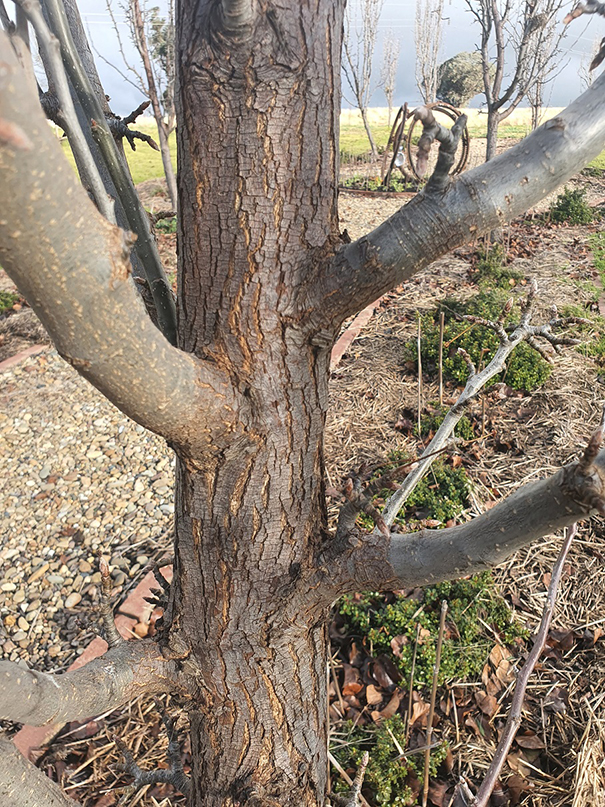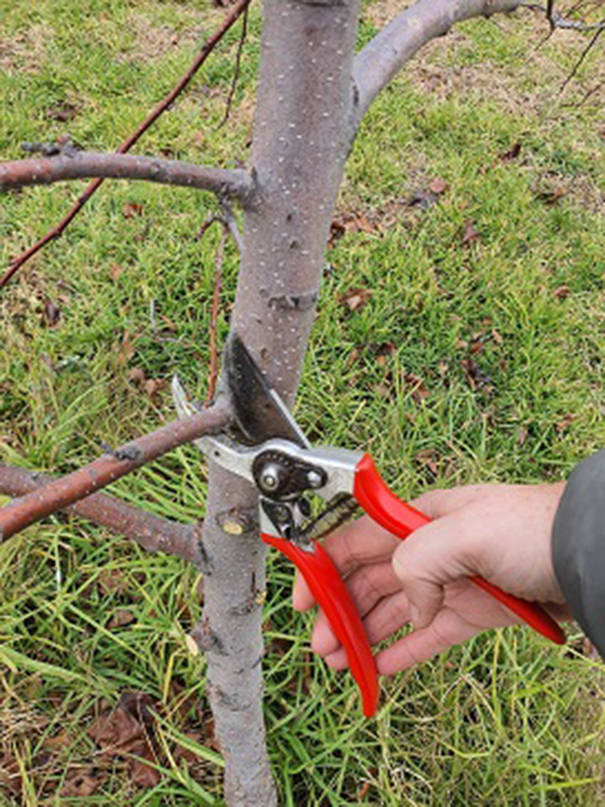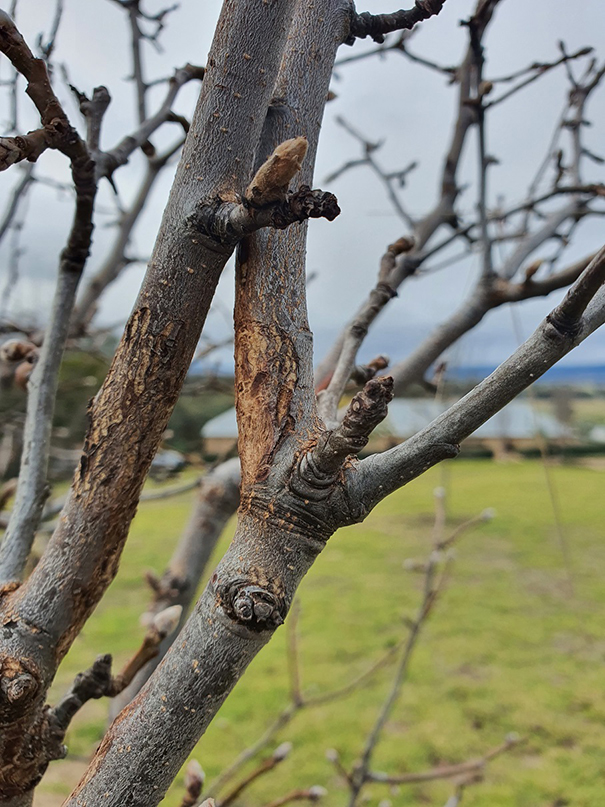
09 Jul Winter Tree Pruning
It is at this time of year, when all the leaves have fallen from the canopies of deciduous trees that you can really see the true shape and habit of your deciduous trees.
These clearer views makes it a great time to prune your deciduous trees. It is also a good time to prune many evergreen trees and shrubs such as Conifers, Olives and Citrus (if finished fruiting) and Camellias (when they have finished flowering). If any of the trees or shrubs are spring flowering then you will need to know if they flower on new wood (this is the growth that will appear in the coming spring) or old wood (this is the growth from the previous year). If they flower on new wood, then you can prune in Winter. If they flower on old wood, then they should be left until they finish flowering.
Some examples of trees and shrubs that flower on new wood and can be pruned now are Abelia, Buddleia, Crepe Myrtle, Hydrangeas, Red and Yellow stemmed Dogwoods.
Some examples of trees and shrubs that flower on old wood that should be pruned after they flower in spring are Azaleas, Rhododendrons, Deutzia, Lilacs, Pieris, Forsythia, Weigelia, White flowering Dogwood and Deciduous Magnolias.
It is always important to consider the safety risks with any pruning before starting I would recommend that if it is a tree say greater than two – three metres in height you should employ a professional to do the work. When using any pruning equipment or ladders all care should be taken that you work in a safe and healthy environment.
What is Winter Dormancy
It is almost like the hibernation period that many animals go through for winter. This dormancy that deciduous trees go through, commences with the loss of their leaves. The tree’s metabolism, energy consumption and growth will completely slow down in the cooler months.
Why prune in Winter Dormancy
It is an ideal time to prune for a number of reasons;
Pruning the tree through winter will cause less stress to the tree and the tree will recover more quickly from any pruning wounds when the warmer weather arrives in spring. As soon as the tree’s metabolism starts to pick up, the tree will start producing new wood to callous over the pruning wounds.
Without the leaves you can easily see the overall structure of the tree – so you can clearly see which branches are crossing over each other? or the ones that might be damaged or diseased.
It is less likely that the pruning wounds will become infected or diseases as the cooler temperatures means there is less activity with any pathogens or insects. It is also good to try and do the prune on a mild dry day not in rain as pruning in dry conditions will help prevent the spread of any waterborne diseases.
You will see the positive results of your pruning quite quickly as spring is only around the corner.


What pruning should be completed on the trees
The first task to do is to identify and remove any dead, dying, damaged or diseased branches. I would then recommend to remove any suckers that may have shot from the graft union. If you have trees trained with clear trunks then I would remove any of these branches below the main canopy. All of these branches should be cut back to the main stem/trunk or to a side branch. I would then stand back and look at the overall shape and structure of the tree. Are there crossing branches that will or are rubbing up against each other. One of these branches should be removed to prevent the damage they will cause.
Are there branches growing out across access ways or up against buildings. Will they continue to grow and cause issues? These branches may need to be removed entirely or at least reduced in size.
Is the canopy balanced or asymmetrical?
Can the tree grow to its natural habit in this location?
It is always worth consulting with a qualified arborist before commencing tree pruning or employ a professional to do the work especially on larger trees.
Types of Pruning
Some terms that are used regularly around tree pruning and training that may help you understand tree management a bit better;
Crown lifting – this is when you clear the lower branches on the trunk to give a height clearance between ground level and the lowest branches within the canopy. This is ideally used when you need to give user access underneath the canopy of the tree or access for mowing underneath the tree or to open up views
Formative pruning – This is the method of pruning and training that should be started on trees from an early age. It is training the tree to a single leader and creating good branch structure , arrangement and spacing. The overall natural habit of the tree should be considered before doing any of this pruning.
Reduction Pruning – This is the pruning of a longer branch back to a shorter length. These branches might be heavily weighted on the outer ends of the branch which could cause them to break in windy or storm conditions.
Crown thinning – This is the removal of crowded branches within the canopy to allow more light through the canopy, improve air flow and improve structure.

This image shows the branch collar on pear tree
Where to Prune
When pruning smaller branches within the canopies, you should always prune back to a side branch or bud. Make the cut on the angle. You need to consider where this cut is made as to the direction it will re shoot in.
When cutting back larger branches to the main trunk you should cut the branch along the branch collar.
This collar is more visible on some species than others. The branch collar is found between the main trunk and the base of the branch sometimes the collar almost forms a ridge. Refer to image opposite.
You should make the cut along the branch collar. By cutting here you leave the area where the meristematic tissue is located that will then produce new wood to heal over the wound.
If you do cut closer to the trunk, on the trunk side of the branch collar you will remove the plant tissue that is there to heal over the scar. This is known as a flush cut. The pruning scar will not heal over and could open the tree up to decay at this point.
If you cut too high above the branch collar you will leave a section of branch that will dieback to the branch collar. This wound will become a piece of dead wood which can then open the tree up to further decay as well.
What tools to use?
When it comes to do any pruning you should attempt to have the right tools for the job. These tools can vary between gardeners depending on what you like to use.
It all comes down to personal taste. It is also worth noting that every form of pruning tool has its limitations which you need to know. If you try to cut a branch with a tool that is too small you will either do damage to the tool, the branch or yourself.
I always like to use the following tools;
Long handed and short handed loppers
The two different lengths in handles allows you to reach into different sections of the tree depending on their size. Also the different thickness or width of the stem or branch may require some extra leverage for cutting.Pruning saw
I use this almost as much as my secateurs. The saw allows you to get into tight areas where your secateurs can’t reach.Long sleeved gloves
These can protect your arms and clothing from being scratched and battered. I have an aversion to spiky plants. It is just not fun spend all of the day getting spiked in every direction whilst you are trying to do a garden task so wearing some extra protection will definitely help you work a bit quicker.Secateurs
My Felco No 2 secateurs are my ultimate favourite garden tool of all time! If you speak to many gardeners especially those who garden professionally you will know that a pair of secateurs are a very personalised item one that I can’t live without. It is the only item in my garden tool kit that I would not share or lend out. I have a strong attachment to mine and they are moulded to my hand shape so much that when you are completing a lot of pruning they feel like an extension of your hand. You always need to ensure they are sharp and the fittings are tightened before you do any large amounts of pruning

Pole Pruner
This piece of equipment is for larger branches that sit higher in the tree. They are heavily weight so you need to be able to manage and control the equipment. They have a hedging attachment and a chainsaw attachment.Chainsaw
This is a more specialised and powerful piece of equipment. It will allow you to cut larger diameter branches however with more power also come more technique and more risk.

Safety comes first
When pruning you should always have the correct personal protective equipment (PPE) such as gloves, ear muffs for ear protection, glasses for eye protection, hard hat with face shield, protective kevlar trousers for use with chainsaw, steel capped boots, long sleeve shirt with no loose pieces of fabric hanging around your body.
Cleaning tools
If you are removing diseased wood on any plants you should wipe down your blades between plants. You could wash blades with warm soapy water and then wipe down with tea tree oil, diluted bleach or methylated spirits. Rinse this off then wipe dry. This will stop the spread of disease from one plant to another.
Pruning in the warmer months
You may still need to prune your trees in Spring and or Summer as many trees that have their main flowering or fruiting through the warmer months will benefit from some pruning straight after flowering.
You may notice if it is a warm wet spring, the amount of new growth produced on the tree may be overwhelming and some reduction pruning, crown lifting, thinning out and or shaping might be needed to improve light and air circulation.
Also sometimes you may miss some of the dead wood throughout the canopy of the tree as without an untrained eye it can be easy to miss when the total tree is bare.



